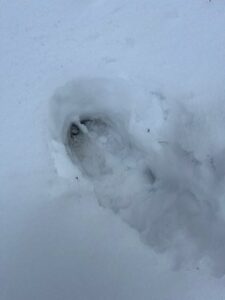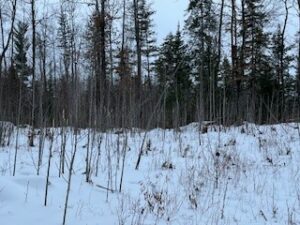28-01-2024
15:49 hours
200 acre forest – privately owned
North Algona Wilberforce, Ontario
45°35’0″N 77°3’20″W
2°C (feels like 0°C), cloudy, 6km/h wind
The area of interest is approximately 0.5 km by 0.5 km which includes a swamp/marsh area with an open field in front of it. The area of interest is not densely populated with trees and very little dried plants are present. The dried plants observed were common burdock. The swamp/marsh area is frozen over and snow covered. The open area in front of it had approximately one foot of snow on the ground. There is a small camp built approximately 2 kilometers away, with a road built in from the main road. It is recreationally used, mainly in November for deer hunting season.
Species of trees noted were:
- poplar,
- ironwood,
- maples,
- cedar and,
- white pine.
Moose tracks were observed in the snow leading up to young poplar trees where the branches were broken and pulled down. Approximately 30 poplar trees were broken/pulled down.
Questions:
- Why would the moose be biting off branches and pulling them down to the ground?
- No deer tracks or scat were observed in this area, meanwhile multiple tracks and scat were observed in other areas leading up to this specific site. Weather related or lack of coverage?
- I did not see or hear any bird activity – Why?



Sounds like a great study site. I would focus on questions along a gradient instead of general questions about bird presence or moose browse. If you are seeing areas with Moose browse, are there other areas where they are not browsing and what factors might be influencing that for example.